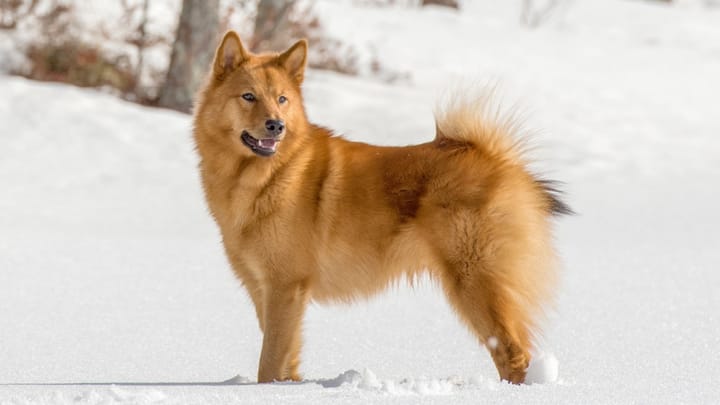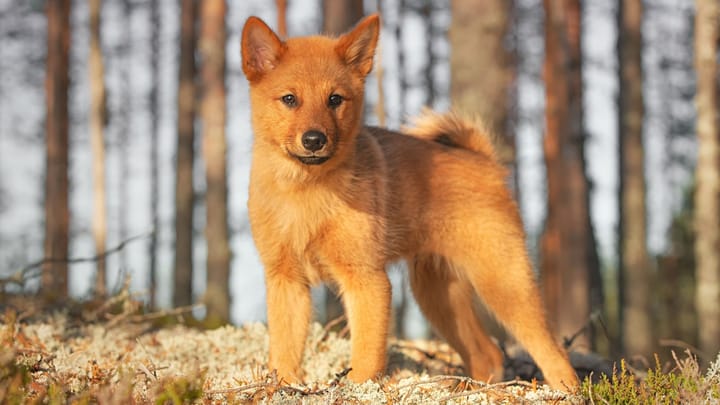Finnish Spitz
Other name: Suomenpystykorva


The Finnish Spitz was originally bred to hunt game and bark loudly when it discovered something. As such, one of this breed’s distinguishing features has to be its excessive barking habit. On the plus side, this does make for a highly efficient watchdog! This talkative pooch does, in fact, have a lot more to offer. With a good-natured, warm and friendly temperament, as well as being patient with children, it can make a fantastic family companion. However, those who choose to adopt a Finnish Spitz will need to be able to keep up with its moderately high exercise needs.
|
Life expectancy |
The Finnish Spitz has a life expectancy of between 12 and 14 years |
|
Temperament |
|
|
Size |
Medium
|
|
Adult size |
Female
Between 15 and 18 in
Male
Between 17 and 20 in
|
|
Adult weight |
Female
Between 15 and 22 lb
Male
Between 26 and 29 lb
|
|
Coat colour
The coat can be varying bright shades, ranging from golden to deep red, often with white markings on the toes and chest. |
Red Sand |
|
Type of coat
Thick, stiff overcoat on the neck, shoulders, and back, and a soft, think undercoat. |
Short |
|
Eye colour
The eyes are a dark colour. |
Brown
|
|
Purchase price |
The Finnish Spitz costs between £725 and £1000 |
The Finnish Spitz is officially the National Dog of Finland - quite a title!
More details about the Finnish Spitz
Finnish Spitz: Origins and history
The Finnish Spitz is believed to have descended from ancient hunting dogs of Scandinavia and Lapland, eventually bred with Spitz-type dogs for the purpose of hunting small game. The breed standard was established in 1812 and is known as the Suomenpystykorva in its native Finland, where it’s still popular as both a hunting and companion dog to this day.
Physical characteristics of the Finnish Spitz
The Finnish Spitz is a medium-sized dog which is often compared to a fox in terms of appearance. With its long, pointed muzzle, erect, pricked ears and vibrant red coats, we can certainly see the similarity! This breed has a squarish, well-built body, muscular legs and a deep chest.
FCI classification of the Finnish Spitz
-
Group 5 - Spitz and primitive types
-
Section 2 : Nordic Hunting Dogs
Finnish Spitz: Characteristics
Finnish Spitz: Behaviour
Training a Finnish Spitz
Despite this breed’s independent temperament, it is a very cooperative dog when it is communicated with respectfully, and its needs have been met. The Finnish Spitz can be highly sensitive to harsh criticism, so the best approach is a fair yet firm voice, a gentle touch and plenty of positive reinforcement. Training sessions should be short as this breed gets bored easily. Be aware that training may take some time and patience, but it’s best to avoid scolding your dog - that’s likely to take you ten steps back.
Finnish Spitz: Lifestyle
Breed compatibility Finnish Spitz
Finnish Spitz: Purchase price
This breed will cost between £725 for Non-KC Registered dogs, and £1000 for KC-Registered dogs. Looking after a dog of this size typically costs between £60 to £90 a month, including food, medical/insurance, and incidental expenses.
Finnish Spitz: Shedding
Average
This breed is a moderate shedder.
Finnish Spitz: Grooming
For most of the year, the Finnish Spitz is nice and easy to care for, requiring just a weekly brush. However, this breed sheds seasonally. During these times, you’ll need to brush them more regularly to avoid a hair-covered house! The rest is standard doggy care. Bathe your pooch only if it’s absolutely needed, as excess bathing can dry out the skin. Trim the nails if necessary, check and clean the ears regularly and brush the teeth daily.
Finnish Spitz: Health
This is a generally healthy breed with few genetic health problems. The life expectancy of this breed is 13 years.
The Finnish Spitz is known to be a robust, resilient and hardy breed.
This dog has a good constitution and doesn’t fear the heat.
This Nordic breed thrives in cold weather and can tolerate bitter conditions.
The Finnish Spitz does love its food - but as long as its exercise needs are met and food portions are controlled, it’s unlikely to gain excess weight.
- Hip dysplasia
- Patellar luxation
- Epilepsy






